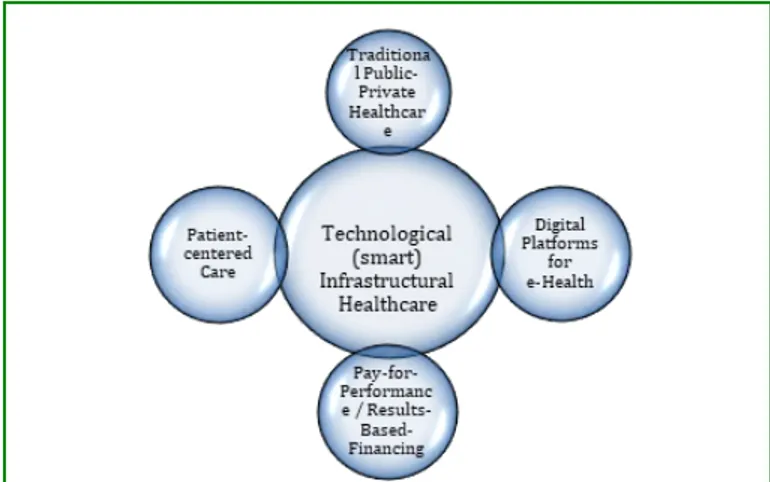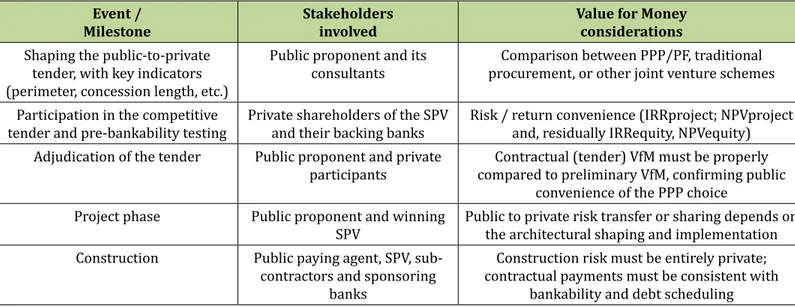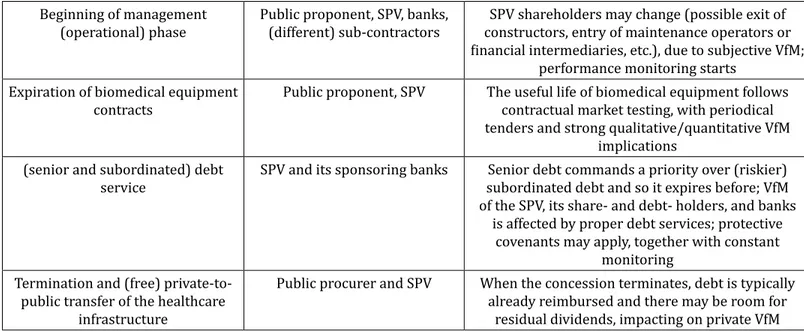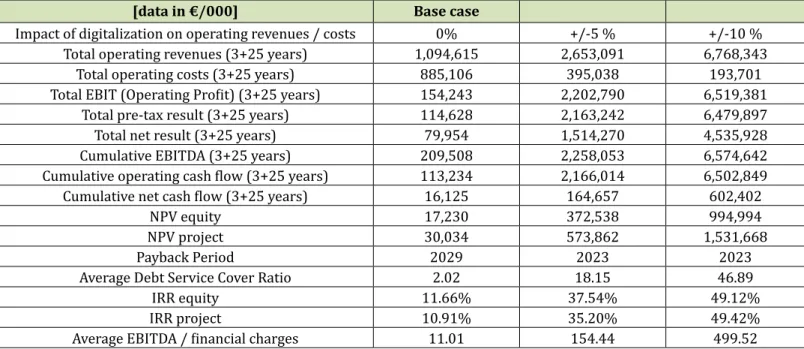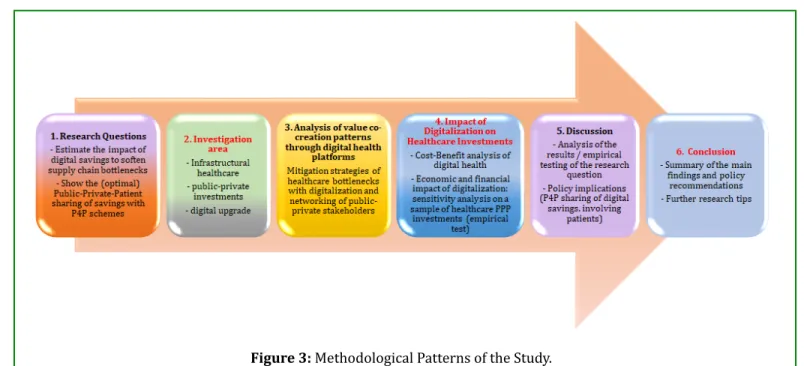Review Article Volume 2 Issue 1
Digital Technology and Efficiency Gains in Healthcare
Infrastructural Investments
Roberto Moro-Visconti
1* and Maria Cristina Quirici
21Professor of Corporate Finance, Catholic University of the Sacred Heart, Italy
2Professor of Economics of Financial Intermediaries–Department of Economics and Management, University of Pisa, Italy
*Corresponding author: Roberto Moro Visconti, Professor of Corporate Finance, Department of Business Administration,
Catholic University of the Sacred Heart, Largo A.Gemelli 1, 20123 Milano, Italy, Email: [email protected]
Received Date: April 23, 2019; Published Date: May 26, 2020
Abstract
Background: Healthcare investments represent a central infrastructure with growing sustainability issues, due to the aging
population, public budgetary pressures, and higher quality standards. Public providers of healthcare services increasingly interact with experienced private suppliers. They share Value for Money (VfM), to achieve efficiency gains through an optimal combination of benefits and costs. Innovative solutions are so needed, as they combine the target of increasing healthcare quality with economic savings.
Objectives: To analyze the economic benefit of digitalization and indicate how the value-adding “pie” can be shared between
the public, the private, and the patients. To show that achievements due to digitalization are financially sustainable, consistently with public capital rationing concerns.
Methodology: A critical analysis of the VfM parameter is conducted to understand how the public and private interests can
converge. Digital platforms are a core feature of the technological upgrades, and their incremental impact on value creation is investigated with a cost-benefit sensitivity analysis.
Findings: If technological advances produce savings, investments may be remunerated with Pay-for-Performance incentives.
Digital platforms add value to the whole ecosystem, linking the stakeholders together in real-time, and favoring data sharing. Digital patterns also favor social distancing, so crucial during pandemics. This study goes beyond the extant literature, considering the public-private sharing patterns of technological expertise.
Conclusion: Digitalization, through transmission and sharing of (big) data, involves traditionally forgotten stakeholders,
represented by patients. This ignites a paradigm shift easing a patient-centric outlook consistent with the trendy expectations of the healthcare industry.
Keywords:
e-health; Digital reimagination; Patient-centered care; Digital platforms; Smart hospital; Pay-for-PerformanceAbbreviations:
IOT: Internet Of Things; EBIT: Earnings Before Interests and Taxes; EBITDA: Earnings Before Interests and Taxes, Depreciation, and Amortization; NPV:Net Present Value; IRR: Internal Rate of Return; EHRs: Electronic Health Records.
Introduction
Healthcare investments represent a central social infrastructure with growing sustainability issues, due to the aging population, and public budgetary pressures. Care delivery models are changing fast due to the increasing cost of care, need to improve access to care, growing complexity in treatment, and increasing involvement of patients [1]. Healthcare systems are facing many challenges, from demographics to multi-morbidities that are associated with increasing the demand for more services. New technologies are thought to be a solution to these problems. However, to address these problems with the digitalization of healthcare will imply the combination of safely using technologies, aligned with integrated working processes and skilled professionals [2]. The global digital health market was valued at approximately USD 120 billion in 2017 and is expected to generate revenue of around USD 380 -420 billion by the end of 2024, growing at a cumulated average growth rate of 20-25% between 2018 and 2024 [3,4].
Healthcare is a highly networked and systemic industry, with a practical impact on projects, which need to be well introduced in the territory and synergic with other healthcare and infrastructural facilities.Recent research has demonstrated that many investors seek investments that yield social benefits in addition to financial returns. The emerging practice of “impact investing” embraces this duality by constructing investment portfolios that jointly optimize both types of outcomes. Smart hospitals represent the latest frontier of healthcare impact investments. Within this evolving framework, there are some innovative forms of public-private cooperation. The public authorities that are willing to refresh their healthcare offer increasingly need the technological expertise of private players. Healthcare PF is the financing of long-term hospital infrastructures based upon a complex financial structure where project debt and equity are used to finance the project, rather than to reward project sponsors. The importance of public care is confirmed also by the on-going pandemics since universal healthcare coverage is most effective in preventing or limiting the spread of the disease. Fair allocation of scarce medical resources emerges as a vital issue [5]. Digitalization can help in many complementary ways, favoring e-health intervention that keeps ill people at home and saving resources that can be dedicated to vital tasks. Transformation of in-patients into out-patients and eventually home-patients is, whenever possible, a mighty goal. A new concept of VfM so emerges, involving the three key players of the healthcare ecosystem: the public procurer that can mitigate competition and promote universal health coverage, the private actors (including big pharma), and the patients. This is a hotly debated issue, especially in the US, that deserves further attention in a pandemic scenario where the uncured
patients may infect those who can afford private healthcare. Consistently with this framework, the research question of the study is the following:
• Which is the impact of digitalization on the returns of a private player that runs a technological (smart) infrastructural investment?
• Which are the procedures that preside over the partitioning of the “pie” (added value) that is created by the digitalization? And which is the most efficient “pie” sharing between the public, the private, and the patients? • The interacting research topics and literature streams
are synthetically represented in Figure 1.
Figure 1: Interacting research topics and literature
streams.
A short recap of the literature streams is the following: • Literature surveys about traditional PPP healthcare can
be found in.
• Digital platforms for e-health are investigated in. • Pay-for-Performance models in healthcare are analyzed
in. Value-for-Money implications on public-private ventures are examined [6-12].
• Patient-centred care is examined in Moro Visconti R, et al. [13] and satisfaction of patients’ needs in Moro Visconti R, et al. [14]
• Smart healthcare investments are explored in.
Cost savings from healthcare digitalization are shown in Moro Visconti R, et al. [15] according to which the digital health care model may be a less costly alternative to the traditional health care model. Under the concept of eHealth, many different types of digital innovations for health and medical care are found, including those for diagnostics, information management, and communication. Development in the field of eHealth and related services is progressing rapidly and will most likely continue to affect current healthcare systems in various ways. These technical developments have led to a simultaneous increase in the expectation that they will lead
to significant efficiency gains and reductions in overall health spending. Although there are several studies concerning the remuneration of the performance in healthcare, little attention has been dedicated to technological investments that are co-directed and managed by public and private players [16-18]. This study represents an advance in the literature since it considers the impact of digitalization (in terms of cost-benefit analysis) on healthcare infrastructural investments.
A Flexible Convergence of Public and Private Interests
Public-private partnerships traditionally deal with hospital construction and management of non-core activities, which represent the backbone of the investment. Point out that “hospital infrastructure is designed for a lifespan of more than 40 years. During this life, demands on the infrastructure will change significantly. Unforeseeable advances in medical technology, unpredictable national and local demographic changes in the wake of globalization, changing epidemiological patterns driven by lifestyle changes, and rapid regulatory changes make scale and scope of the demand on any individual hospital over its lifetime highly unpredictable. A good value-for-money hospital infrastructure, therefore, needs to be flexible, to allow effective adaptation to changing circumstances”.
Flexibility, to be incorporated in the investment design, is a real option, which represents the right - but not the obligation - to undertake the business initiative, such as deferring, abandoning, expanding, staging, or contracting a capital investment project. Flexibility needs to be exercised with cost efficiency along the whole public-to-private concession period and must be properly adapted to the intrinsically rigid
infrastructural characteristics of the investment. Resilience is, however, uneasy to model ex-ante and to contract out and it may have an impact on forecast cash flows, so influencing Net Present Value and Internal Rate of Return of the project, to be analyzed within a corporate finance framework [19], and exemplified in the empirical case.
Risk mitigation is a key issue, both from the public and the private side. It may concern:
• digital specialization of the agent (public or private) which professionally deals with a specific risk;
• risk-sharing among different subjects (e.g., multiple shareholders of the private SPV);
• putting quality first; a good construction, maintenance, and management of infrastructural healthcare can substantially decrease risks and related costs.
Dynamic Timesheets and Agency Milestones
While the investment perimeter shapes the healthcare project, its dynamic evolution represents a complementary key element for proper analysis of the investment patterns. PPP stakeholders deeply change their roles and expectations across time and so does dynamic and interactive VfM. Consequential milestones shape corporate governance issues, strongly affecting risk/reward patterns: for example, stakeholders change their composition and mission when construction is completed, and the management phase starts. The temporal extension of binding contracts is also strongly variable within the whole concession period, which normally consists of some 3 years of project and construction (refurbishment of existing structures is typically more complex), followed by some 15 to 25 years of management. Table 1 shows an evolutionary sample with timely milestones.
Event /
Milestone Stakeholdersinvolved Value for Moneyconsiderations
Shaping the public-to-private tender, with key indicators (perimeter, concession length, etc.)
Public proponent and its
consultants procurement, or other joint venture schemesComparison between PPP/PF, traditional Participation in the competitive
tender and pre-bankability testing Private shareholders of the SPV and their backing banks Risk / return convenience (IRRproject; NPVproject and, residually IRRequity, NPVequity) Adjudication of the tender Public proponent and private
participants compared to preliminary VfM, confirming public Contractual (tender) VfM must be properly convenience of the PPP choice
Project phase Public proponent and winning
SPV Public to private risk transfer or sharing depends on the architectural shaping and implementation Construction Public paying agent, SPV,
sub-contractors and sponsoring banks
Construction risk must be entirely private; contractual payments must be consistent with
Beginning of management
(operational) phase Public proponent, SPV, banks, (different) sub-contractors constructors, entry of maintenance operators or SPV shareholders may change (possible exit of financial intermediaries, etc.), due to subjective VfM;
performance monitoring starts Expiration of biomedical equipment
contracts Public proponent, SPV The useful life of biomedical equipment follows contractual market testing, with periodical tenders and strong qualitative/quantitative VfM
implications (senior and subordinated) debt
service SPV and its sponsoring banks subordinated debt and so it expires before; VfM Senior debt commands a priority over (riskier) of the SPV, its share- and debt- holders, and banks
is affected by proper debt services; protective covenants may apply, together with constant
monitoring Termination and (free)
private-to-public transfer of the healthcare infrastructure
Public procurer and SPV When the concession terminates, debt is typically already reimbursed and there may be room for
residual dividends, impacting on private VfM
Table 1: Investment milestones and Value for Money.
Digital Technologies and Smart Hospitals
Moro Visconti R, et al. [20] show that a smart hospital relies on optimized and automated processes built on an ICT environment of interconnected assets, particularly based on the Internet of things (IoT), to improve existing patient care procedures and introduce new capabilities. Smart (technological) hospitals represent a long-termed investment where public and private players interact with banks and eventually patients, to satisfy a core welfare need. The infrastructural investments may be related to
new buildings, the revamping of existing facilities, or the realization of technological upgrading. Restructuring of old facilities is often economically inconvenient, and the concept of smart hospitals is so typically referred to new investments [15]. Smart hospitals are a key enabler in driving clinical excellence, patient-centric care, and operational efficiency. Digital technologies may be implemented through networking platforms [21] that instantaneously connect the main stakeholders that rotate around the healthcare infrastructure, as shown in Figure 2.
public partner [private] sub-contractors private partner (SPV) patients and users DIGITAL PLATFORM
Figure 2: Digital Network of Interacting Stakeholders.
From Figure 2 it intuitively appears that the networking node
performs intermediation functions, easing the transactions among the stakeholders. In any case, the platform is an intermediator of information that is collected, gathered (in the cloud), and processed (with artificial intelligence patterns), becoming worthy big data (increasingly validated through blockchain applications).
An Empirical Simulation
An empirical case adapted from Moro Visconti R, et al. [22]
considers the typical accounts of a private SPV that runs a public hospital for 25 years of concession (after 3 years of project and construction) under a PPP agreement. The base case is represented by the accounts of a digital-free SPV that increases its revenues and decreases its operating costs thanks to the introduction of digitalization. The impact of digitalization is estimated with a +5% or +10% increase in revenues and a specular decrease in costs. Evidence is shown in Table 3.
[data in €/000] Base case
Impact of digitalization on operating revenues / costs 0% +/-5 % +/-10 % Total operating revenues (3+25 years) 1,094,615 2,653,091 6,768,343
Total operating costs (3+25 years) 885,106 395,038 193,701 Total EBIT (Operating Profit) (3+25 years) 154,243 2,202,790 6,519,381
Total pre-tax result (3+25 years) 114,628 2,163,242 6,479,897 Total net result (3+25 years) 79,954 1,514,270 4,535,928 Cumulative EBITDA (3+25 years) 209,508 2,258,053 6,574,642 Cumulative operating cash flow (3+25 years) 113,234 2,166,014 6,502,849 Cumulative net cash flow (3+25 years) 16,125 164,657 602,402
NPV equity 17,230 372,538 994,994 NPV project 30,034 573,862 1,531,668
Payback Period 2029 2023 2023
Average Debt Service Cover Ratio 2.02 18.15 46.89
IRR equity 11.66% 37.54% 49.12%
IRR project 10.91% 35.20% 49.42% Average EBITDA / financial charges 11.01 154.44 499.52
Table 3: Sensitivity of the Infrastructural Healthcare Investment to a Digital Impact on Higher Revenues (+5%; +10%) and
Lower Costs (-5%; -10%).
In Figure 3, the EBIT (Earnings before Interests and Taxes) represents the operating profit of the private player and the EBITDA (Earnings before Interests and Taxes, Depreciation, and Amortization) the liquidity created within the income statement from the ordinary business. The operating cash flow indicates the liquidity before debt service, and the net cash flow corresponds to the free cash flow belonging to the shareholders (the owners of the private SPV), after debt service. While the project’s Net Present Value (NPVproject) represents the cumulative value attributable to lenders and shareholders, and its Internal Rate of Return (IRRproject) indicates the breakeven hurdle rate, residual equity indicators (NPVequity; IRRequity) show the shareholders’ remuneration. The higher the IRR, the more profitable the investment. The payback indicates the time necessary to reach a financial breakeven (when cash inflows match cash outflows), and the cover ratio measures the capacity of the firm to serve outstanding financial debt (the higher the ratio, the sounder the firm). The EBITDA / financial charges ratio corresponds to the capacity to create operating liquidity (proxied by the
EBITDA) to pay off negative interests, serving financial debt. The simulated +5%/+10% increase in revenues and the corresponding decrease in costs (that may well be asymmetric, this just being an example) are prudential, especially if a long-time span (25 years of concession) is considered. The improvements in terms of value creation (proxied by the NPV) are impressive, and they show that the private “pie” that is created is substantial and fit for being shared. The “pie” (to be divided with the public actor and the patients) is represented by the incremental value of the key parameters in the second and third scenarios, as compared to the base case.A strong incentive for fair sharing (to avoid undeserved private rents) comes from the private competition towards lucrative projects and the binding agreements of the public-to-private contract. This sensitivity estimate represents just a template, and the variation in revenues and costs is fully backed by empirical evidence. Electronic health records (EHRs) can, for instance, bring to consistent savings and efficiency gains [23].
Discussion
A brief discussion analyses the results, proposing a methodology to share the digital “pie” among the involved stakeholders (public and private actors; patients). This solution may be represented by a Pay-for-Performance mechanism, traditionally used in healthcare but seldom applied to digital innovations. Empirical evidence shows that digital investments are intrinsically convenient, and they can be fuelled by worthy big data. Big data could reduce US health care expenditures by about 8% [24]. Digitalization eases the exchange of information, sharing data in real-time, and permitting instant booking or access to Digital Health Records [25]. Public healthcare budget constraints bring to the following dilemma: even if digital investments normally surpass cost-benefit analysis testing, the public player often lacks the money and the skills to implement them. On the other side, cooperation with the private actor may be expensive, and so unbearable in a public deficit context. A possible solution may be represented by Pay-for-Performance (P4P) patterns. P4P for health is a cash payment or non-monetary transfer made to a provider as an incentive to deliver priority healthcare services. Payment is made conditional on measurable actions. P4P is an umbrella term that includes results-based contracts with healthcare providers; output-based aid; and conditional cash transfers and other demands. Within a P4P scheme, the public actor, constantly short of cash, does not anticipate payments that are financed only by realized savings.
The P4P model provides a system of economic incentives for private players acting together with public actors. This
coordination is consistent with a PPP model that is widely used in healthcare [7], and with the networking attitudes of digital platforms. P4P is complementary to mHealth and remunerates digital efforts, like for instance the adoption of Electronic Health Records. Incentives are a powerful catalyzer of innovation efforts, and the insights that derive from the combination of the research question with the empirical example may be summarized as follows:
• The benefits deriving from digitalization of healthcare investments are evident and this innovation is worth undertaking;
• The cost-benefit analysis shows that digitalization is fully consistent with public budget constraints;
• Revenues and value created from digitalization may be conveniently shared among the main stakeholders that are involved in this process; this strategy is consistent with a patient-centric approach;
• Whereas the private incentives are exclusively monetary, for the other stakeholders they are mixed. Both the public and the patients are eager to save money, but they also look for improved quality, consistently with a VfM maximization target.
The “digital pie” can ignite a win-win process where value co-creation produces further (monetary and non-monetary) returns. P4P patterns can so contribute to the solution of the envisaged dilemma, incentivizing technological upgrades driven by the private initiative and remunerated through shared savings that are fully consistent with public budget constraints. Figure 3 summarizes the methodological steps of the study.
Conclusion
Healthcare infrastructural investments have extended duration and a complex gestation process. They are capital intensive, highly leveraged, and difficult to evaluate - all characteristics that make them intrinsically risky. For the public procurer, VfM (a measure for efficiency gains) is a key parameter in orienting the choice between internalized or outsourced healthcare choices. The findings of this study are based on an empirical case that concerns a public-private joint venture backed by a PF scheme, but they may be easily extended to different situations, and generalized to any healthcare infrastructural investment. They also confirm the usefulness of digitalization, even in a wider context. E-health or m-health applications are now routinely embedded in smart investments [21], and they rotate around networked digital platforms. This digital ecosystem is increasingly patient-centric [26], due also to the better circulation of information.
This study analyses complementary cost-benefit issues, with an evolutionary approach where public-private stakeholders with diverging interests cooperate. Due to public budget constraints, technological investments may be conveniently sponsored through P4P incentives. The trendy ecosystem is represented by an e-health compliant digital network. Digitalization adds up enormous value to the healthcare industry, and it eases healthy behaviours as social distancing, so important during pandemics like the Covid-19 / Coronavirus outbreak of 2020. Further interdisciplinary research is needed in this complex and rapidly evolving field, also concerning the risk assessment, in a crucial field such as infrastructural healthcare investing. Insights from this study may be conveniently extended to other industries where public and private players cooperate to implement innovative digital investments.
Ethical Issue / Conflicts of Interest:
None.References
1. Moro Visconti R, Martiniello L, Morea D, Gebennini E (2019) Can Public-Private partnerships Foster Investment Sustainability in Smart Hospitals? Sustainability 11(6): 1704.
2. Lapão LV (2019) The Future of Healthcare: The Impact of Digitalization on Healthcare Services Performance. The Internet and Health in Brazil. Springer, pp: 435-449. 3. Zion (2019) Digital Health Market - Global Industry
Perspective, Comprehensive Analysis and Forecast, 2017-2024.
4. Market Research Future (2019) Digital Healthcare Market Research Report - Global Forecast till 2025. 5. Ezekiel J Emanuel, Govind Persad, Ross Upshur, Beatriz
Thome, Michael Parker, et al. (2020) Fair Allocation of Scarce Medical Resources in the Time of Covid-19. N Engl J Med.
6. Hellowell M (2018) Public Private Partnerships and the Quality and Efficiency of Healthcare Services. Public-Private Partnerships in Health, pp: 1-13.
7. Moro Visconti R, Doś A, Pelin Gurgun A (2017) Public-Private Partnerships for Sustainable Healthcare in Emerging Economies. In: Leitão J, Sarmento EM, Aleluia J, (Eds.), Handbook on PPS in developing and emerging economies.
8. Archenaa J, Anita MA (2015) Survey of big data analytics in healthcare and government. Procedia Computer Science 50(1): 408-413.
9. Bates DW, Saria S, Ohno-Machado L, Shah A, Escobar G (2014) Big data in health care: Using analytics to identify and manage high-risk and high-cost patients. Health Aff(Millwood) 33(7): 1123-1131.
10. Fogel AL, Kvedar JC (2016) Simple Digital Technologies Can Reduce Health Care Costs. Harvard Bus Rev.
11. Grittner AM (2013) Results-based financing: evidence from performance-based financing in the health sector. Discussion Paper 6.
12. Cui C, Wang J, Liu J, Coffey V (2019) Relationships among Value-for-Money Drivers of Public–Private Partnership Infrastructure Projects. Journal of Infrastruct Systems 25(2).
13. Moro Visconti R, Martiniello L (2019) Smart Hospitals and Patient-Centered Governance. Corporate Ownership & Control 16(2): 83-96.
14. Moro Visconti R, Morea D (2019) Big Data for the Sustainability of Healthcare Project Financing. Sustainability 11(13): 3748.
15. Ekman B (2017) Cost Analysis of a Digital Health Care Model in Sweden. Pharmacoecon Open 2(3): 347-354. 16. Turcotte-Tremblay, Anne-Marie, Spagnolo Jessica,
De Allegri, Manuela, Ridde, Valéry (2016) Does performance-based financing increase value for money in low- and middle- income countries? A systematic review. Health Economics Review 6(30).
in Health Practice: Reflections on Implementation from Experiences in Six Countries. Health, Nutrition and Population Knowledge Brief. World Bank, Washington DC.
18. De Neufville R, Lee YS, Scholtes S (2008) Using flexibility to improve value-for-money in hospital infrastructure investments. 1st International Conference on Infrastructure Systems and Services: Building Networks for a Brighter Future. INFRA 5439668.
19. Moro Visconti R (2013) Managing Healthcare Project Financing Investments: a corporate finance perspective. Journal of Investment and Management 2(1): 10-22. 20. (2020) European Union Agency for Network and
Information Security. Smart Hospitals, ENISA.
21. Yablonsky S (2020) A multidimensional platform ecosystem framework. Kybernetes.
22. Moro Visconti R, Morea D (2020) Healthcare
Digitalization and Pay-For-Performance Incentives in Smart Hospital Project Financing. Int J Environ Res Public Health 17(7): 2318.
23. Klenk J, Sharma Y, Fan J (2016) Saving Lives with Big Data: Unocking the Hidden Potential in Electronic Health Records. Big Data and Business Analytics, Taylor & Francis, Milton Park.
24. McKinsey & Company (2011) Big Data: the next frontier for innovation, competition, and productivity.
25. Kruse CS, Stein A, Thomas H, Kaur H (2018) The use of Electronic Health Records to Support Population Health: A Systematic Review of the Literature. J Med Syst 42(11): 214.
26. Mishon EV, Sokolov AA, Breslavtseva NA (2019) Analysis of Healthcare Digitalization Trends and Tools for Their Implementation.Digital Economy: Complexity and Variety vs. Rationality. ISC 2019. Lecture Notes in Networks and Systems 87: 541-547.
